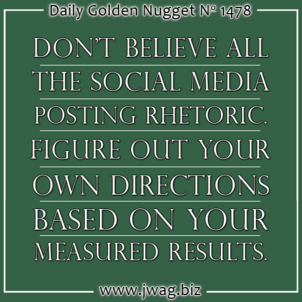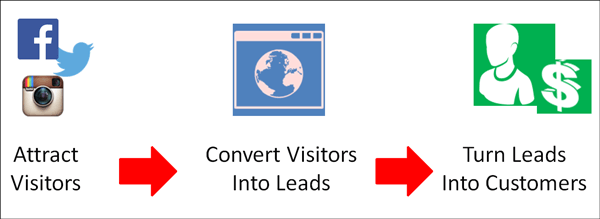
Social media marketing is quite frustrating. The rules seem to change every time you think you understand the right methods of how and when to share to social media. Most internet marketers will lead you to believe that business success will come if you can get 10,000 or more fans following you on every network, when in reality it takes a bit more than just growing your social fan base.
Somehow those social media fans have to be converted into sales as shown in this diagram:

Having 10,000+ fans on your social network might make you feel good, but it doesn't represent any real sales per month. As illustrated in the above diagram, you somehow need to track the activity from the social network to your website and from your website to the final sale. Facebook, Twitter, and Pinterest have built-in ways to track business analytics, but that built-in measurement is not enough, you need something better.
Better Social Tracking
The tracking built into the social networks provides a false sense of accomplishment of our social activity. Measuring engagements simply doesn't help to pay the bills at the end of the week. A better method of tracking must be used that will guide you in the right direction for what to post and when to post.
With the right tracking you'll be able to share pages of your website to your social media accounts in such a way that allows for tracking every time one of those shared links are clicked. Assuming you are already sharing pages from your website to social media, a social account with 10,000 fans would be lucky to have 100 real website referrals in a month.
The default tracking in Google Analytics doesn't make the tracking of those 100 referrals very easy, and the social networks don't help much at all either. You have to set up your own tracking for this.
I'd like to refer you back to this post on UTM tracking that I wrote a few years ago. It explains the basics you need to know to set up the right social media tracking. After reading those directions on UTM tracking, you'll understand that there are 5 tracking tags that can be added to every web page link you share to your social accounts.
I'll illustrate with a specific example with this URL:
http://www.jwag.biz/newsletters/2015/05/19/the-misunderstood-cost-of-the-marketing-funnel.html
These are the 5 tracking tags that I want to add to that URL:
utm_term=340PM
utm_source=jwagfb
utm_medium=fb
utm_content=daily_nugget
utm_campaign=2015-05-19
utm_source=jwagfb
utm_medium=fb
utm_content=daily_nugget
utm_campaign=2015-05-19
This is what the URL looks like when I add the tags to it:
http://www.jwag.biz/newsletters/2015/05/19/the-misunderstood-cost-of-the-marketing-funnel.html?utm_term=340PM&utm_source=jwagfb&utm_medium=fb&utm_content=daily_nugget&utm_campaign=2015-05-19
That URL is quite long and ugly, and I would not share that directly to social media. Instead, I would use the Bitly.com service to shorten it to this:
http://bit.ly/1Gk7B2O
That shorter URL is less threatening when you see it on a social network. People are less likely to click on the long, confusing URL that is not shortened.
Once you implement this tracking, you'll be able to monitor your social media clicks by following the directions explained here.
Tracking Conversions to Sales
The social media tracking won't provide enough information to completely help your business. The referral clicks from social media are reassuring, but they still don't pay the bills. Once people click over to your website, you have to further track their activity, turn them into a sales lead, and then convert them into a real sale as shown here:

If you're lucky, you can turn 10,000 social media fans into 100 referrals per month, and then you can potentially turn 10 of those 100 into buying customers.
Getting the clicks to your website from social media is the easy part; tedious, but easy. Once they are on your site you have to figure out how to turn them into sales leads, which is usually done by getting them to fill out an online form. That form can be your newsletter signup, a request for the latest special offer, or a registration for an upcoming event; whatever it is, that form allows you to capture the name and email address of the person. That's called a conversion, or simply a sales lead.
Those sales leads won't usually turn into buying customers right away. You'll have to add them to your mailing list and tag them with Facebook and AdWords cookies in order to remind them of you every once in a while. Eventually they will turn into a sale.
The last stage of the tracking requires either an ecommerce website that tracks sales, or for you to manually correlate your in-store sales to your customer email list. With a little work, you should be able to create the in-store sales reports on your own, but you'll have to ask your website programmer for help setting up the ecommerce tracking.
Creating Your Own Blueprint
From shared social links to final sales, over time you will discover what types of shared website content leads to a sale. It might take many months to fully map this out, but after a while you'll have a blueprint of the content that's most beneficial to your bottom line sales.
Although I'm not getting into the specifics here, that blueprint will show you the ROI of each type of content on each social network. In the end, you'll have a very specific set of social media sharing directions for your unique business.








